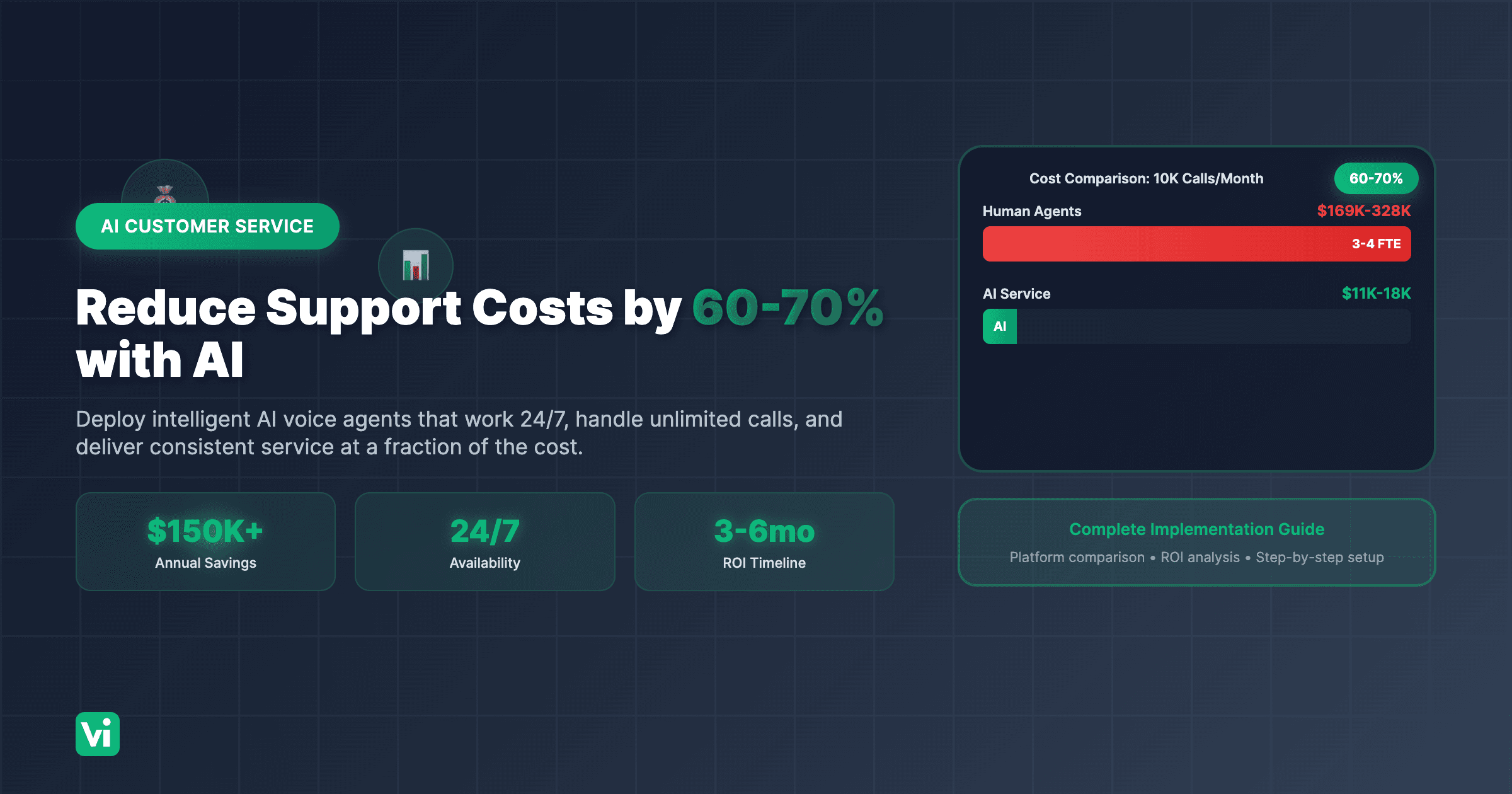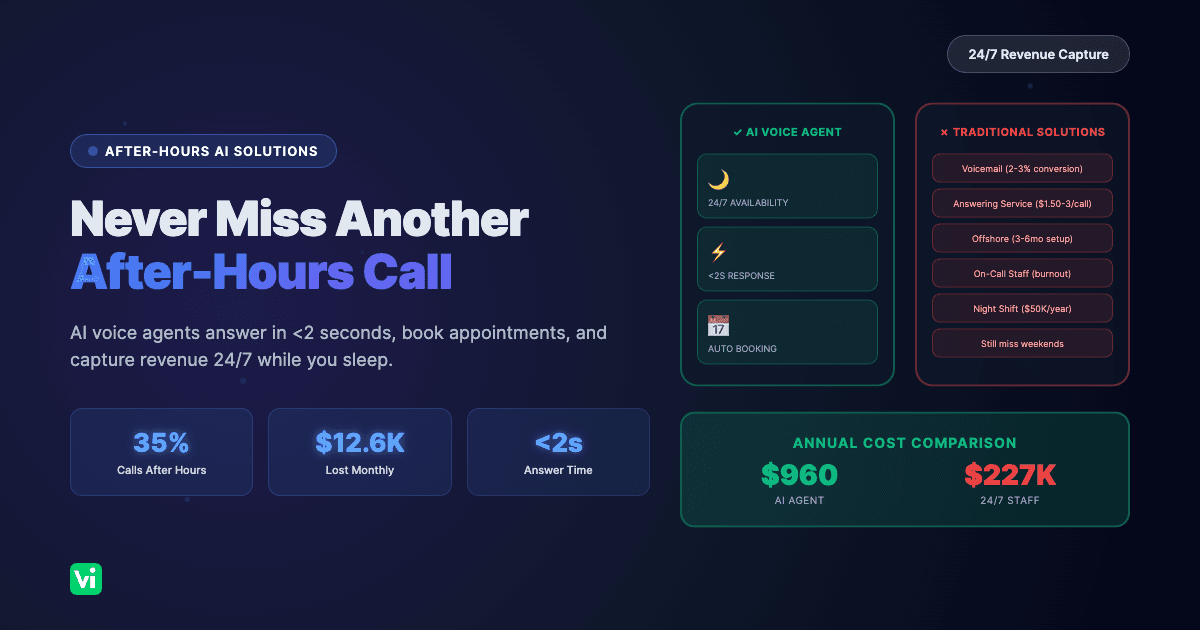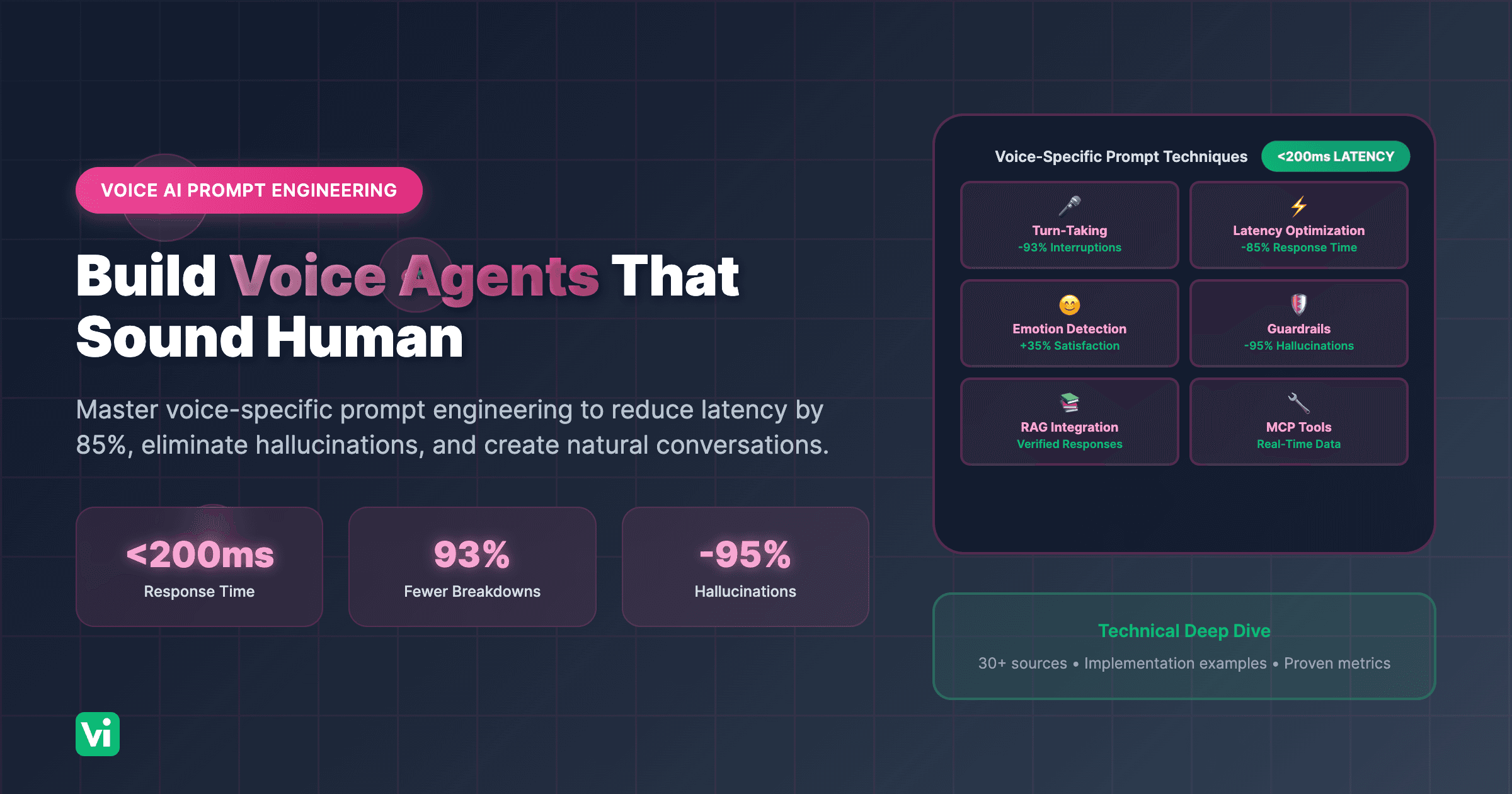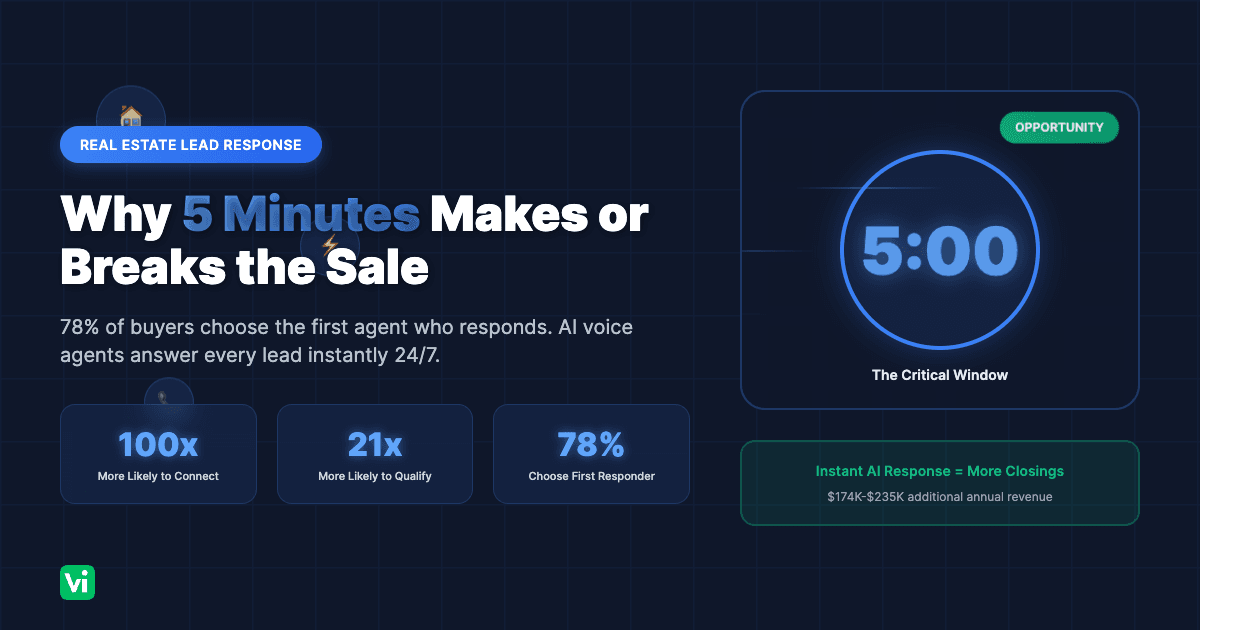Your customer service team is drowning.
Every phone call during lunch rush goes to voicemail. Every after-hours inquiry becomes a lost opportunity. Every hold time over 2 minutes pushes customers toward your competitors. And every human agent you hire costs over $ 35,000 annually, while still being limited to 40 hours per week.
Here's the reality: 78% of organizations already utilize AI-powered customer service, and 95% of customer interactions are predicted to be AI-driven in the near future. The businesses thriving aren't just adding more staff; they're deploying intelligent automation that works 24/7, costs 60% less, and delivers faster, more consistent service.
The breakthrough: Modern AI customer service platforms don't just answer questions; they understand context, detect emotion, integrate with your systems, and seamlessly escalate to humans when needed. All while reducing costs by 40-65% and improving customer satisfaction.
What Is AI Customer Service? (And Why It's Not Just Chatbots)
The Complete Definition
AI customer service utilizes artificial intelligence technologies, including natural language processing (NLP), machine learning, conversational AI, and voice synthesis, to automate customer support interactions across various channels, such as phone, chat, email, and messaging.
However, here's what most businesses overlook: Modern AI customer service extends far beyond simple chatbots that follow scripted responses.
Modern AI customer service includes:
Voice AI agents that handle phone calls with human-like conversation
Conversational AI that understands context, intent, and emotion
Intelligent routing that knows when to escalate to human agents
Real-time integrations with CRM, scheduling, and business systems
Multi-channel support across phone, chat, WhatsApp, and web
Predictive analytics that anticipate customer needs before they ask
How AI Customer Service Actually Works
The Technical Process:
Customer Contact → AI Processing → Intent Recognition → Response Generation → Action/Escalation
What Happens Behind the Scenes:
Customer initiates contact via phone, chat, or messaging
Speech/text recognition converts input to structured data
Natural language understanding identifies intent and context
AI model processes requests using a trained knowledge base
Response generation creates a natural, contextual reply
Action execution completes tasks or escalates to humans
Learning loop improves future interactions based on outcomes
The Technology Stack:
Large Language Models (LLMs): OpenAI, Claude, Gemini for reasoning
Voice Synthesis: ElevenLabs, Cartesia, OpenAI for natural speech
Speech Recognition: Deepgram, Whisper for accurate transcription
Integration Layer: APIs connecting to CRM, calendars, and databases
Analytics Engine: Real-time monitoring and performance optimization
The AI Customer Service Market: Statistics That Matter
Adoption & Growth
Market Reality:
78% of organizations currently use AI in customer service operations
Multi-billion dollar market growing at 23.9% CAGR
95% of customer interactions predicted to be AI-powered in the near future
87.2% customer acceptance rate for AI-powered support
Why Businesses Are Switching:
40-65% cost reduction compared to human-only support
3.50 ROI for every one invested in AI customer service
24/7 availability without overtime or staffing costs
Customer Expectations Have Changed
What Customers Demand Today:
Instant responses: 64% expect real-time answers regardless of channel
24/7 availability: 35% of business calls happen after hours
Consistent quality: 73% cite consistency as key to loyalty
Personalization: 80% more likely to purchase with personalized experiences
The Cost of Not Meeting Expectations:
5.91% call abandonment rate with 3+ minute hold times
16% satisfaction drop for every second of latency
35% of after-hours calls go to voicemail (lost opportunities)
$75 billion annually is lost to poor customer service
Types of AI Customer Service Solutions (And Which One You Need)
1. Text-Based Chatbots (Entry Level)
What They Are: Rule-based or AI-powered chat interfaces that handle text conversations on websites, apps, or messaging platforms.
Best For:
Simple FAQ responses
Basic information lookup
Form collection and lead capture
Low-complexity support queries
Limitations:
No voice capability
Limited emotional intelligence
Struggles with complex issues
Requires typing from customers
Cost: $50-500/month for basic platforms
2. Voice AI Agents (Advanced)
What They Are: Conversational AI systems that handle phone calls with natural, human-like voice interactions.
Best For:
Phone-based customer service
Appointment scheduling and reminders
Lead qualification and sales
Complex problem-solving conversations
After-hours coverage
Advantages:
Natural voice conversations
Emotion detection and adaptation
Real-time system integrations
Seamless human escalation
Multi-language support
Cost: Usage-based pricing, typically $0.05-0.20 per minute
3. Hybrid AI + Human Systems (Enterprise)
What They Are: Integrated platforms where AI handles routine tasks and intelligently routes complex issues to human specialists.
Best For:
Large-scale operations
Complex product ecosystems
High-value customer segments
Regulated industries (healthcare, finance)
How It Works:
AI handles 60-80% of routine inquiries
Smart escalation based on complexity, sentiment, VIP status
Human agents receive the whole conversation context
Continuous learning from human interactions
Cost: Custom enterprise pricing
4. Conversational AI Platforms (Full-Stack)
What They Are: Complete AI customer service ecosystems with voice, chat, email, and messaging capabilities unified in one platform.
Best For:
Omnichannel customer experience
Enterprise-scale operations
Complex integration requirements
Advanced analytics and reporting needs
Features:
Multi-channel support (phone, chat, email, WhatsApp, SMS)
Unified customer data and conversation history
Advanced analytics and sentiment tracking
Workflow automation and CRM integration
Custom AI training and optimization
Cost: $500-10,000+/month depending on volume
How to Implement AI Customer Service: Step-by-Step Guide
Phase 1: Assessment & Planning (Week 1)
Step 1: Analyze Current Support Operations
Document call volume by time of day and day of week
Identify the most common customer inquiries (80/20 rule applies)
Calculate the current cost per interaction
Measure average response time and resolution time
Track customer satisfaction scores (CSAT, NPS)
Step 2: Define AI Use Cases
High-volume, low-complexity: FAQ, hours/location, pricing
Repetitive tasks: Appointment scheduling, order status, and password resets
After-hours coverage: Lead capture, basic support, emergency routing
Overflow handling: Peak time support, seasonal spikes
Step 3: Set Success Metrics
Cost reduction targets (40-65% is realistic)
Response time improvement goals
Customer satisfaction maintenance/improvement
Call resolution rate expectations
ROI timeline (typically 3-6 months)
Phase 2: Platform Selection (Week 2)
Evaluation Criteria:
1. Voice Quality & Naturalness
Test actual conversations, not just demos
Evaluate response latency
Check emotion detection capabilities
Verify multi-language support if needed
2. Integration Capabilities
CRM connectivity (Salesforce, HubSpot, etc.)
Calendar and scheduling systems
Payment processing, if needed
Custom API support for proprietary systems
3. Scalability & Reliability
Concurrent call capacity
Uptime SLA (99.9% minimum for enterprise)
Geographic coverage and redundancy
Peak load handling capabilities
4. Cost Structure
Setup fees vs ongoing costs
Per-minute vs subscription pricing
Scaling costs as volume grows
Hidden fees for features or integrations
5. Ease of Implementation
Setup time (60 minutes vs weeks)
Technical requirements
Training and knowledge base setup
Ongoing maintenance needs
Phase 3: Knowledge Base Setup (Week 2-3)
Step 1: Content Collection
Website content (automatic crawling available)
FAQ documents and support articles
Product specifications and pricing
Company policies and procedures
Common troubleshooting guides
Step 2: Knowledge Organization
Structure information by topic and priority
Create clear, concise answers to common questions
Define escalation triggers for complex issues
Set up dynamic content for personalization
Step 3: Integration Configuration
Connect CRM for customer data access
Link calendar systems for scheduling
Configure payment processing if needed
Set up custom functions for business logic
Phase 4: Testing & Optimization (Week 3-4)
Testing Protocol:
Internal testing: Team members make test calls covering all scenarios
Edge case testing: Unusual requests, angry customers, complex issues
Integration testing: Verify CRM updates, calendar bookings, and data accuracy
Load testing: Simulate peak call volumes
Escalation testing: Confirm smooth handoffs to human agents
Optimization Areas:
Conversation flow refinement
Response accuracy improvement
Escalation threshold tuning
Voice personality adjustment
Integration reliability verification
Phase 5: Gradual Rollout (Week 4-6)
Recommended Approach:
Week 1: After-Hours Only
Deploy AI for calls outside business hours
Low-risk environment for real-world testing
Capture opportunities currently going to voicemail
Monitor performance and gather feedback
Week 2-3: Overflow Support
AI handles calls when human agents are busy
Reduces hold times during peak periods
Maintains human touch for immediate availability
Builds confidence in AI capabilities
Week 4-6: Primary Support with Human Backup
AI becomes the first point of contact
Complex issues escalate to human specialists
Humans focus on high-value interactions
Continuous monitoring and optimization
Phase 6: Monitoring & Continuous Improvement (Ongoing)
Key Metrics to Track:
Call volume: Total calls, AI-handled vs escalated
Resolution rate: Percentage resolved without human intervention
Customer satisfaction: CSAT scores for AI interactions
Response time: Average time to first response
Cost per interaction: Total cost divided by interactions
Escalation rate: Percentage requiring human assistance
Optimization Cycle:
Weekly review of call transcripts and outcomes
Monthly analysis of trends and patterns
Quarterly knowledge base updates
Continuous AI model improvements
Why VoiceInfra for AI Customer Service
1. Multi-Provider AI Optimization Unlike platforms locked to single AI providers, VoiceInfra gives you access to:
OpenAI Realtime (default) - Reliable, fast, cost-effective
Anthropic Claude 3.5 Sonnet - Complex reasoning, nuanced conversations
Google Gemini - Multilingual excellence, broad knowledge
Groq - Ultra-fast inference for speed-critical applications
Result: Best-in-class performance by matching the right AI to each use case.
2. Ultra-Realistic Voice Quality Premium voice providers create conversations so natural that customers don't realize they're talking to AI:
ElevenLabs: Professional voice cloning with accent selection
Cartesia: Fast, natural voice synthesis for real-time conversations
Rime Labs: High-quality multilingual voices
OpenAI: Integrated voice synthesis with GPT
Result: Customer acceptance rates above 87% with minimal friction.
3. Instant Deployment While competitors require weeks or months of implementation:
Connect your existing PBX numbers and extensions, Twilio numbers, or WhatsApp Business numbers
Upload business knowledge (website crawler or documents)
Configure call routing and integrations
Go live immediately
Result: Start capturing value today, not next quarter.
4. Enterprise-Grade Reliability
99.9% uptime SLA with multi-region redundancy
Global infrastructure for low-latency worldwide
Enterprise security standards built in
Result: Reliability that matches or exceeds traditional call centers.
5. Flexible, Transparent Pricing
Start free: $10 free credit when you create an account
Pay-as-you-go: $0.05/minute platform fee + AI/voice costs
No vendor lock-in: Cancel anytime, no long-term contracts
Predictable scaling: Costs grow proportionally with usage
Result: Accessible to startups, scalable to enterprise.
AI vs Human Customer Service: The Complete Comparison
When AI Excels
Routine Inquiries (60-80% of Volume):
Hours of operation and location information
Pricing and product specifications
Order status and tracking
Account balance and basic transactions
Appointment scheduling and reminders
Password resets and basic troubleshooting
AI Advantages:
Instant response: No hold times vs 2-5 minute average waits
Perfect consistency: Same quality in every interaction
24/7 availability: No overtime, holidays, or sick days
Unlimited scale: Handle 1000+ concurrent calls
Zero errors: Accurate pricing, policies, and information
Cost efficiency: 60-70% lower than human agents
When Humans Are Essential
Complex Situations (20-40% of Volume):
Emotional or sensitive issues (complaints, refunds, cancellations)
Complex technical troubleshooting requires expertise
High-value sales negotiations
Nuanced policy exceptions and judgment calls
Crisis management and de-escalation
Building long-term customer relationships
Human Advantages:
Emotional intelligence: Genuine empathy and understanding
Creative problem-solving: Outside-the-box thinking
Relationship building: Personal connection and trust
Complex reasoning: Multi-step logic and judgment
Brand representation: Human face of the company
The Optimal Hybrid Approach
Best Practice Model:
AI handles first contact for all inquiries (100%)
AI resolves routine issues independently (60-80%)
Smart escalation routes complex issues to humans (20-40%)
Context handoff provides the full conversation history
Human specialists focus on high-value interactions
Continuous learning improves AI from human resolutions
Result: Lower costs, faster service, higher satisfaction, better employee experience.
Cost Analysis: AI Customer Service ROI
Traditional Human-Only Support Costs
Per Full-Time Agent (Annual):
Base salary: $35,000-50,000
Benefits (30%): $10,500-15,000
Training and onboarding: $3,000-5,000
Management overhead (20%): $7,000-10,000
Tools and software: $1,000-2,000
Total per agent: $56,500-82,000
Limitations:
40 hours/week maximum (2,080 hours/year)
Vacation, sick days, and breaks reduce availability
Inconsistent quality based on experience and mood
Limited to ~30-50 calls per day
Cannot scale instantly for peak periods
Cost per interaction: $15-25 (including overhead)
AI Customer Service Costs (VoiceInfra Example)
Platform Costs:
Platform fee: $0.05/minute
LLM (GPT-4o Mini Realtime): $0.14/minute
Voice synthesis (ElevenLabs): $0.10/minute
Speech-to-text (Deepgram): $0.0043/minute
Total per minute: ~$0.30
Average call duration: 3-5 minutes Cost per interaction: $0.90-1.50
Annual costs for 10,000 calls/month:
Human agents (3-4 FTE): $169,500-328,000
AI customer service: $10,800-18,000
Savings: $150,700-310,000 (89-94% reduction)
Industry-Specific AI Customer Service Applications
Healthcare & Medical Practices
Use Cases:
24/7 appointment scheduling: Patients book anytime, reducing no-shows
Insurance verification: Automated benefits checking and pre-authorization
Prescription refills: Routine medication requests handled instantly
Symptom triage: Initial assessment and appropriate routing
Appointment reminders: Proactive outreach reduces no-shows by 42%
Results:
67% improvement in appointment adherence
35% increase in scheduling efficiency
28% reduction in administrative workload
Secure patient data handling with proper platform selection
E-commerce & Retail
Use Cases:
Order status and tracking: Instant updates without agent involvement
Product information: Detailed specifications, availability, and pricing
Return processing: Automated authorization and shipping labels
Inventory inquiries: Real-time stock checking across locations
Promotional support: Campaign information and discount codes
Results:
60% reduction in support ticket volume
24/7 availability increases conversion rates
Faster resolution improves customer satisfaction
Reduced cart abandonment through instant support
Professional Services (Legal, Accounting, Consulting)
Use Cases:
Lead qualification: Pre-screen prospects before attorney/consultant time
Consultation booking: Calendar integration with availability checking
Document collection: Guide clients through required paperwork
Billing inquiries: Payment status and invoice information
Follow-up automation: Systematic client check-ins
Results:
40% increase in lead conversion rates
60% reduction in time-to-contact
Higher-value use of professional time
Improved client communication consistency
Home Services (HVAC, Plumbing, Electrical)
Use Cases:
Emergency dispatch: 24/7 triage of urgent vs routine requests
Estimate scheduling: Automated booking of on-site consultations
Service reminders: Proactive maintenance scheduling
Payment processing: Secure collection over the phone
Follow-up calls:
Customer satisfaction and quality assurance
Results:
24/7 emergency coverage without on-call staff
45% increase in estimated bookings
Improved cash flow through automated payment collection
Higher customer retention through proactive outreach
Financial Services & Insurance
Use Cases:
Account inquiries: Balance, transaction history, statement requests
Claims processing: FNOL (First Notice of Loss) collection
Payment processing: Automated payment collection and confirmation
Fraud alerts: Security verification and account protection
Loan applications: Initial qualification and document collection
Results:
45% reduction in claims processing time
96% first-time completion rate for FNOL
67% improvement in document submission rates
Enhanced security through consistent verification protocols
Future Trends in AI Customer Service
1. Emotional AI & Sentiment Adaptation
What's Coming: AI systems that detect subtle emotional cues and adapt conversation style in real-time based on customer mood, stress level, and satisfaction.
Impact:
More empathetic, human-like interactions
Proactive de-escalation of frustrated customers
Personalized communication styles per customer
Improved satisfaction through emotional intelligence
2. Predictive Customer Service
What's Coming: AI that anticipates customer needs before they contact support, proactively reaching out with solutions.
Examples:
Detecting potential product issues from usage patterns
Proactive outreach before subscription renewals
Anticipating questions based on the customer journey stage
Automated problem resolution before customer awareness
Impact:
Shift from reactive to proactive support
Reduced inbound contact volume
Higher customer satisfaction through prevention
Increased retention and loyalty
3. Visual AI & Multimodal Support
What's Coming: AI agents that can see what customers see through screen sharing, photo analysis, and video guidance.
Applications:
Visual troubleshooting for technical issues
Product assembly guidance with real-time feedback
Damage assessment for insurance claims
Remote diagnostics for equipment problems
Impact:
Faster problem resolution
Reduced need for on-site visits
Better first-call resolution rates
Enhanced customer experience
4. Hyper-Personalization at Scale
What's Coming: AI that remembers every interaction, preference, and context across all channels and touchpoints.
Features:
Continuous conversation across channels (phone, chat, email)
Personalized greetings and context awareness
Preference learning and adaptation
Predictive recommendations based on history
Impact:
Customers feel known and valued
Reduced repetition and frustration
Higher conversion and retention rates
Competitive differentiation through experience
5. Autonomous Problem Resolution
What's Coming: AI agents with authority to make decisions, process refunds, apply discounts, and resolve issues without human approval.
Capabilities:
Automated refund processing within parameters
Dynamic pricing and discount application
Account modifications and updates
Complex multi-step problem resolution
Impact:
Instant resolution without escalation
Reduced resolution time from hours to seconds
Lower operational costs
Higher customer satisfaction
Frequently Asked Questions About AI Customer Service
How much does AI customer service cost compared to human agents?
AI customer service typically costs 60-70% less than human agents. While a full-time human agent costs $56,500-$82,000 annually (including salary, benefits, training, and overhead), AI platforms like VoiceInfra cost approximately $0.30-$0.50 per minute of interaction. For a business handling 10,000 calls monthly, AI costs $10,800-$18,000 annually, compared to $169,500-$328,000 for human agents, resulting in a savings of $158,700-$310,000 per year.
Will AI customer service replace human agents completely?
No. The optimal model is a hybrid: AI handles 60-80% of routine inquiries (pricing, hours, order status, scheduling), while human agents focus on complex issues that require empathy, judgment, and creative problem-solving. This approach reduces costs while improving both customer experience and employee satisfaction by eliminating repetitive work.
How long does it take to implement AI customer service?
Implementation time varies by platform. Traditional enterprise solutions require 3-6 months of setup, integration, and training. Modern voice-first platforms, such as VoiceInfra, can be deployed in minutes to a week, depending on their complexity. The fastest path: connect your existing phone system, upload your knowledge base, and go live immediately.
What's the difference between chatbots and AI customer service?
Chatbots are text-based interfaces that follow scripted responses or simple AI logic. AI customer service encompasses voice agents, conversational AI, intelligent routing, real-time integrations, and multi-channel support. Modern AI customer service uses advanced LLMs (GPT-4, Claude, Gemini) for natural conversations, emotion detection, and complex problem-solving, far beyond basic chatbot capabilities.
How do I know if my business needs AI customer service?
Consider AI customer service if you experience:
High call volume with repetitive questions (60%+ routine inquiries)
After-hours calls going to voicemail (35% of calls outside business hours)
Long hold times during peak periods (3+ minutes average)
High support costs relative to revenue (15%+ of revenue)
Difficulty scaling support during growth or seasonal peaks
Customer complaints about slow response times
What are the risks of implementing AI customer service?
Main risks include:
Poor implementation: Choosing the wrong platform or inadequate setup
Customer frustration: AI that can't handle complexity or escalate properly
Brand damage: Impersonal experience, if not balanced with human touch
Integration failures: Technical issues with existing systems
Mitigation strategies:
Start with after-hours or overflow support (low-risk testing)
Choose platforms with smart escalation (VoiceInfra's context handoff)
Monitor satisfaction metrics closely during rollout
Maintain human backup for complex issues
How realistic are AI voice agents compared to human agents?
Modern AI voice agents using premium providers (ElevenLabs, Cartesia, Rime Labs) are so realistic that 87.2% of customers rate them positively or neutrally. With fast response times, natural speech patterns (including "um," pauses, and laughter), and emotion detection, many customers don't realize they're talking to AI until the conversation ends. VoiceInfra's multi-provider approach ensures best-in-class voice quality for every use case.
Can AI customer service integrate with my existing systems?
Yes. Modern AI platforms integrate with:
CRM systems like Salesforce, HubSpot, Pipedrive, Zoho
Calendar platforms like Google Calendar, Outlook, Calendly
Phone systems like 3CX, Asterisk, Avaya, Mitel (via SIP)
Payment processors like Stripe, PayPal, Square
Custom APIs: Any system with REST API access.
VoiceInfra supports the creation of custom functions and Model Context Protocol (MCP) servers for real-time data access during conversations.
What happens when AI can't answer a customer's question?
Smart escalation is critical. Quality AI platforms like VoiceInfra:
Detect complexity beyond AI capabilities
Seamlessly transfer to an appropriate human specialist
Provide full context, including conversation history and customer data
Eliminate repetition so customers don't start over
Learn from escalations to improve future handling
Result: Customers get help without frustration, and human agents receive prepared, qualified interactions.
How do I measure ROI from AI customer service?
Track these metrics:
Cost Metrics:
Cost per interaction (before vs after)
Total support costs (monthly/annual)
Agent headcount and associated costs
Performance Metrics:
Average response time (hold time reduction)
First-call resolution rate
Call abandonment rate
After-hours call capture rate
Customer Metrics:
CSAT (Customer Satisfaction Score)
NPS (Net Promoter Score)
Customer retention rate
Revenue impact from improved service
Typical ROI: 3-6 months to positive ROI with 40-65% cost reduction and improved satisfaction.
Get Started Today
Ready to transform your customer service with AI?
Step 1: Start a free trial at https://voiceinfra.ai/
$10 free credit, no credit card required
Full platform access to test all features
Real phone number provisioning
Complete knowledge base setup
Step 2: Upload your business knowledge
Website crawler for automatic content ingestion
Document upload for policies and procedures
CRM integration for customer data
Custom function creation for business logic
Step 3: Go live instantly
Connect your phone system (PBX extensions, Twilio numbers, or WhatsApp Business)
Configure call routing and integrations
Test with internal calls
Deploy to customers immediately
Step 4: Monitor and optimize
Real-time analytics dashboard
Call transcripts and sentiment analysis
Performance metrics and ROI tracking
Continuous AI improvement
VoiceInfra is the all-in-one Voice AI platform for enterprise telephony. Deploy ultra-realistic AI voice agents instantly via PBX extensions, Twilio numbers, or WhatsApp Business, and reduce customer service costs by 40-65% while delivering 24/7 support. Multi-provider AI access (GPT-4, Claude, Gemini, Groq), premium voice quality (ElevenLabs, Cartesia), and enterprise reliability (a 99.9% uptime SLA) make VoiceInfra the smart choice for businesses serious about AI-powered customer service.



